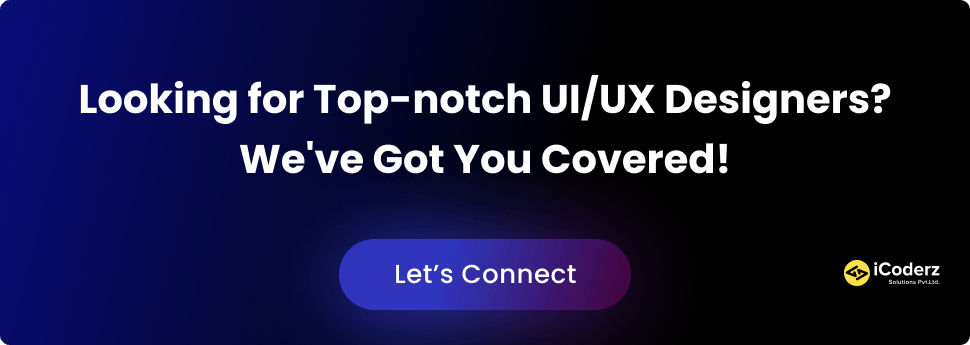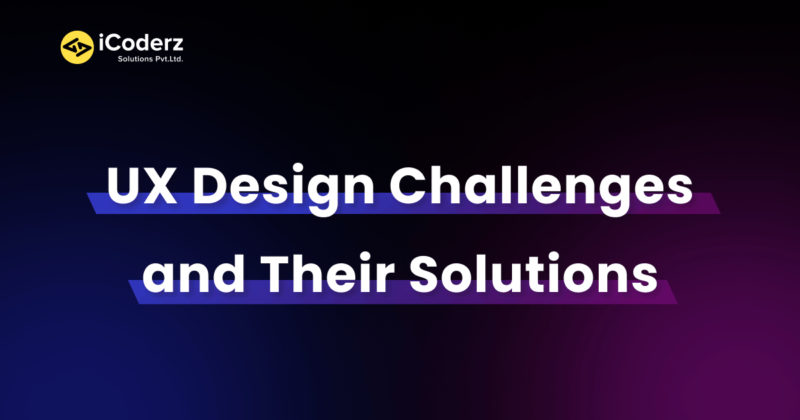Table of Contents
- What is UX Design?
- Top UX Design Challenges and Solutions
- 1. Balancing User Needs and Business Goals
- 2. Designing for Different Devices and Platforms
- 3. Creating Intuitive and Engaging User Interfaces
- 4. Addressing Accessibility and Inclusivity
- 5. Incorporating User Feedback and Iterating Design
- 6. Researching under time and financial constraints
- 7. Design-Development Gap
- Conclusion
User Experience (UX) design is designing digital or physical products, services, and environments that provide users with meaningful and satisfying experiences. UX design aims to improve the usability, accessibility, and desirability of products, and it plays a crucial role in shaping the success of a business. However, UX design is not without its challenges. This article will discuss some of the Top UX Design Challenges and Solutions designers face today. Hire UI/UX Designers to overcome all the challenges and get an amazing app or website.
What is UX Design?
UX design involves creating designs that solve user problems and meet their needs. UX designers use a variety of methods and tools to create effective designs. One of the biggest challenges for UX designers is creating usable and visually appealing designs. Users should be able to use the product easily, but the product should also look good. Another challenge for UX designers is creating designs that work well on multiple devices. With the increasing popularity of mobile devices, UX designers need to create designs that look good on small and large screens.
One solution is to create prototypes early in the design process. This way, you can test your design with users and ensure it’s usable before moving on to the visual design phase. Another solution is to use responsive design principles when creating your designs. This means creating designs that adapt to different screen sizes and device types. You can create better UX designs that meet users’ needs using these solutions.

Top UX Design Challenges and Solutions
1. Balancing User Needs and Business Goals
One of the most significant UX Design Challenges and Solutions is balancing the needs and desires of users with the business goals of the product or service. It is essential to create a design that meets the user’s needs and provides an enjoyable experience while meeting the business’s requirements, such as profitability, market share, and customer retention. To balance user needs and business goals, designers must consider various factors, such as user research, user testing, analytics, and stakeholder input.
Solutions:
To overcome the challenge of balancing user needs and business goals, UX designers can follow these solutions:
- Conduct thorough user research to understand user needs, preferences, and behaviors.
- Define clear and measurable business goals that align with the user’s needs.
- Use data analytics to measure user engagement and track progress toward business goals.
- Involve stakeholders and decision-makers in the design process to ensure their needs and concerns are addressed.
- Use user-centered design principles to create a design that meets user and business requirements.
2. Designing for Different Devices and Platforms
In today’s digital world, users access products and services on various devices, such as desktops, laptops, tablets, smartphones, and different platforms, such as iOS, Android, and web browsers. Designers must create a seamless experience across these devices and platforms, ensuring the design is responsive and accessible on all screen sizes and resolutions. It requires considering the user’s context, such as location, device, and preferences, to deliver a consistent and user-friendly experience.
Solutions:
To design a seamless experience across different devices and platforms, UX designers can follow these solutions:
- Use a system that defines consistent design patterns and components across different platforms.
- Conduct user testing on devices and platforms to identify usability issues or inconsistencies.
- Use platform-specific design guidelines to ensure the design follows best practices and standards.
- Consider the user’s context, location, device, and preferences to deliver a personalized and relevant experience.
3. Creating Intuitive and Engaging User Interfaces
Creating intuitive and engaging user interfaces is another challenge for UX designers. Users expect a design that is easy to use, navigate, and understand, with clear and concise instructions and feedback. Designers must create a visually appealing, consistent, and functional design with appropriate use of color, typography, and visual hierarchy. The design must also provide an engaging experience, encouraging users to explore and interact with the product or service.
Solutions:
To create intuitive and engaging user interfaces, UX designers can follow these solutions:
- Use a clear and consistent visual hierarchy to guide the user’s attention and focus.
- Use color, typography, and visual design to convey meaning and emotions.
- Use micro-interactions and animations to provide feedback and create a sense of delight.
- Conduct user testing to identify usability issues or confusion and refine the design accordingly.
- Use user-centered design principles to create a design that meets the user’s needs and preferences.

4. Addressing Accessibility and Inclusivity
Accessibility and inclusivity are crucial considerations for UX designers. The design must be accessible to users with disabilities, such as hearing and visual impairments, and comply with accessibility standards, such as the Web Content Accessibility Guidelines (WCAG). The design must also be inclusive, considering users’ diverse needs and backgrounds, such as age, culture, language, and gender identity. Designers must ensure that the design is usable and understandable by all users, regardless of their abilities or backgrounds.
Solutions:
To address accessibility and inclusivity, UX designers can follow these solutions:
- Use accessible design patterns and standards, such as WCAG, to ensure the design is usable by users with disabilities.
- Conduct user testing with users with disabilities to identify accessibility issues or barriers.
- Use inclusive design principles to create a design that considers users’ diverse needs and backgrounds.
- Use clear and concise language and avoid jargon or technical terms that may be confusing or exclusionary.
- Use diverse imagery and representation to reflect the diversity of users and avoid stereotypes.
5. Incorporating User Feedback and Iterating Design
Incorporating user feedback and iterating design is an ongoing challenge for UX designers. User feedback is essential for understanding the user’s needs, preferences, and pain points, and it helps designers improve the design’s usability and satisfaction. However, incorporating user feedback requires a willingness to revise the design, test new ideas, and iterate until the design meets the user’s needs. It requires a collaborative and agile approach, with frequent user testing and feedback sessions to refine the design.
Solutions:
To incorporate user feedback and iterate the design, UX designers can follow these solutions:
- Conduct frequent user testing and feedback sessions to gather user input and insights.
- Use data analytics to measure user engagement and identify areas for improvement.
- Use a collaborative and agile design process, such as design thinking or agile methodology, to iterate the design quickly and efficiently.
- Involve stakeholders and decision-makers in the design process to ensure their needs and concerns are addressed.
- Use prototyping and testing tools to test and refine new design ideas quickly.
✔️ ALSO READ: How Much Does It Cost to Design a Mobile App?
6. Researching under time and financial constraints
Researching under time and financial constraints is one of the major challenges that UX designers face. User research is essential to UX design as it provides insights into user behavior, preferences, and needs, which inform design decisions. However, conducting research under tight time and financial constraints can limit the scope and depth of the research. This section will explore this challenge and provide solutions for UX designers to conduct effective research within constraints. Conducting comprehensive research requires time and resources, which may not always be available. Time and financial constraints can limit the scope and quality of the research, leading to incomplete or inaccurate insights into user needs and behaviors. This can result in a suboptimal user experience and a product that fails to meet user needs and expectations.
Solution 1 :
To conduct effective research under time and financial constraints, UX designers must prioritize research activities. They should identify the research activities critical to understanding user needs and behaviors and focus on those activities. This involves determining the most important research questions and designing research methods that provide insights into those questions. Prioritizing research activities helps to ensure that the research provides meaningful and actionable insights that inform design decisions.
Solution 2 :
Agile research methods like rapid prototyping and user testing can help UX designers research within tight time and financial constraints. These methods involve creating prototypes quickly and testing them with users to gather feedback and iterate the design. Agile research methods are iterative and allow UX designers to make design decisions based on user feedback, which helps to create a product that meets user needs and expectations.
7. Design-Development Gap
Design-Development Gap is a common challenge faced by UX designers, where there is a disconnect between a project’s design and development phases. This can lead to design features that are not feasible or difficult to implement, resulting in a product that does not meet user needs and expectations. This section will explore this challenge and provide solutions for UX designers to bridge the design-development gap. The design-development gap occurs when the design phase of a project is completed, but the development team encounters issues in implementing the design features. This can be due to a lack of communication between the design and development teams or a lack of understanding of technical constraints during the design phase. The design-development gap can lead to delays, increased costs, and a product not meeting user needs and expectations.
✔️ Also Read: Core Principles of Design Thinking Process
Solution 1:
To bridge the design-development gap, UX designers should involve developers in the design process. This involves collaborating with developers to understand technical constraints and feasibility during the design phase. Developers can provide valuable feedback on design features and suggest alternative approaches that are easier to implement. This helps ensure the design features are feasible and can be implemented within the project’s scope and timeline.
Solution 2:
Design systems can help bridge the design-development gap by providing a shared language and framework for design and development teams. A design system is a collection of reusable components, styles, and guidelines that define a product’s visual and functional aspects. Design systems ensure design consistency and help streamline development by providing a clear roadmap for implementing design features. Using design systems helps ensure the design features are feasible and can be implemented within the project’s scope and timeline.
Conclusion
UX design is a complex and challenging process that requires a deep understanding of the user’s needs and desires and the business’s goals and objectives. Designers must balance these requirements while creating intuitive, engaging, and accessible designs that work seamlessly across different devices and platforms. It requires incorporating user feedback, iterating the design, and keeping up with emerging technologies and trends. By addressing these challenges, UX designers can create meaningful and satisfying experiences for users and contribute to the success of their businesses.





